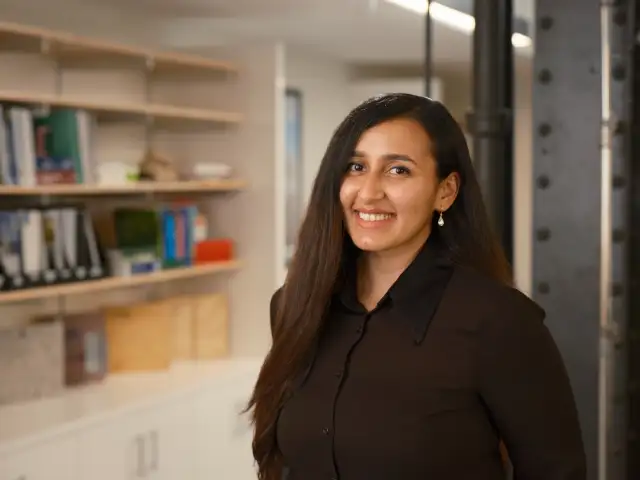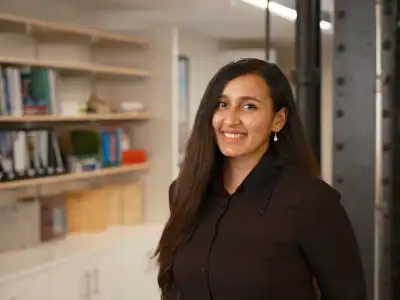Anushka Singh, RDH Building Science Energy and Sustainability Analyst, specializes in whole-building energy modeling, life cycle assessments, thermal analyses of building components, and Passive House consulting. At RDH, Anushka has performed energy modeling for several ongoing Passive House projects in Massachusetts, including Crafts Street Senior Housing in Newton, 104 Walter Street in Roslindale, and the redevelopment of Volpe Building R1 in Cambridge. Recently, Anushka performed the life cycle assessment for Volpe Building R1, which is slated to be completed in 2027 and is part of the larger redevelopment of a 10-acre parcel in Kendall Square. Prior to joining RDH, Anushka worked as an energy modeler and site engineer at a design-build firm specializing in mass timber construction.
Women in Passive House: Anushka Singh


Passive House Accelerator: What inspired you to pursue an education in understanding sustainable building systems?
Anushka Singh: I was inspired by my father, who is a civil engineer. When I was a child, I used to go with him on site visits, and I was always curious to see the construction process and how everything was put together. I still remember how he would always take me to groundbreaking events and talk about the importance of foundations—not only in buildings, but in life, too. I think that's when I knew I wanted to make a career in buildings.
While I was still an undergraduate studying civil engineering in India, I took courses that focused on green and intelligent buildings, as well as smart cities. This is what first piqued my interest in sustainability. It also got me thinking about the relationship between sustainability and development, as well as the tension between short-term growth and long-term survival. You need to always seek out balance between the two.
I decided I wanted to explore the issue further, so I opted to pursue a Master’s in Sustainable Building Systems from Northeastern University. The curriculum has a strong focus on practical application, and the tools and concepts that I learned during that time are essentially what I use in my practice right now. It was an amazing experience.
PHA: Did you have a mentor at Northeastern?
AS: My professor, David Fannon. He influenced my perspective on problem solving. For one of our assignments, we had to go to a green building expo and identify three products or vendors which had environment product declarations. Environmental product declarations are essentially documents that provide transparent and verified information about the environmental impact of a product throughout its lifecycle, from raw material extraction to production, to use, and finally to disposal. It gives you the impact of the product, and it helps consumers and businesses make informed decisions about the environmental performance of products; hence, contributing to sustainable practices.
As per the assignment, we engaged with a variety of vendors and talked to them about these EPDs, with each of us going to at least 15 to 20. Surprisingly, we didn't find many people at the green building expo who were aware of these declarations. Even though we were required to find three examples of EPDs, most of my classmates only found one, maybe two.
When we came back to class to discuss with the professor, he explained that it was his hidden intention to get us to educate people about these declarations. His hope was that they'd go back home and think, “Maybe this is something I should get because it'll help building professionals make sustainable choices.” That really stuck with me—the importance of educating more people in the industry. I think that's one of the best ways to tackle a problem.
PHA: That is a good point. How many years ago was the green building expo?
AS: I think 2019.
PHA: Do you feel as though EPDs have become more common since then?
AS: I've definitely seen more awareness, especially in recent years. People are actively trying to know the performance of the products they're using and putting in their buildings.
PHA: Since graduating, what has your experience been like at RDH in Boston?
AS: It's been amazing. I've had the chance to collaborate with so many people in different offices and from across different time zones. The level of support and appreciation they have for my efforts, time, and knowledge—it's really gratifying. Whenever I work on something, my managers always ask me, "Is that something that interests you?" It's nice to know that they want to provide me with tasks that feed my passions. They're very appreciative of all my work and knowledge.
There's also a consistent effort to keep things engaging, providing ample opportunities to work on all the different facets of construction. For example, my expertise is in energy modeling, but I've had the opportunity to work in enclosure and lifecycle systems. It's been great!
That was also one of the reasons I joined RDH: because it's a big consultancy. We work on different aspects of the construction process. We work on enclosure. We work on energy modeling. We also have site visits. It's a nice balance. It's not just 40 hours of screen work. I get to go on the sites and see the projects I've actually modeled on the software.
PHA: Is there a specific project that you’re particularly proud of?
AS: One of the projects that I worked on a few months back was Volpe Building R1 in Cambridge, Massachusetts. It’s a mixed-used building that is pursuing Phius 2021 certification. I did the energy modeling for that using WUFI® Passive software. It was an energy model update, so it was the second energy model for the project, and it was one of my first WUFI® projects while working with RDH. The experience was amazing.
Luckily, since it was a second model update, there was an established communication system with the client, and they were familiar with the Passive House principles. That helped us ensure a more efficient delivery and a smooth-going process in general. The integrated approach of Passive House—which I think is one of the key elements of the standard—really helps with that.
PHA: What kind of role would you like to see the building industry take to mitigate the effects of climate change?
AS: I think one of the key things is building codes. Including sustainable practices or improving the energy performance requirements for buildings is crucial. It’s already happening in Massachusetts. Another thing would be educating and collaborating. The more people who know how to build the right way, the easier it will be to meet our carbon reduction goals.
There should be more tutorials for everyone in the field: contractors, subcontractors, and active building professionals. Additionally, we need to highlight the importance of an integrated and holistic approach to better streamline communication and ensure efficient delivery. It's important to have everyone on the same page.
PHA: Given the recent adoption of the stretch code in Massachusetts, have you seen more projects that are pursuing Passive House standards?
AS: Yes, I've seen a lot more Passive House projects in the last few months. I started off working with passive houses, and I’ve seen a difference in familiarity. Before, many building professionals would do it just to know the feasibility of it. With the new stretch code, there is more acceptance.
PHA: When you speak with developers or architects, do you feel as though they are now more intimately familiar with Passive House standards, or do you still feel it’s necessary to explain the principles and the big picture idea of Passive House construction?
AS: We still walk through the principles. Even if you're familiar with it, it's good to have a debriefing beforehand to make sure everyone is on the same page. Of course, the more projects there are, the more familiar the concepts will become.
PHA: Do you think Massachusetts’ stretch code can be good model for other states? If so, how do you think they can implement these changes to code successfully?
AS: I think it's going to expand, and I think having public commentary during the drafting phase is helpful. Holding seminars or open discussions to get to know the perspectives of individuals from different professions—the energy modeler, the architect, the developer—and what their thought process is can make implementation smoother.
PHA: As an energy modeler, are there any sustainable building materials that you're particularly excited about?
AS: The embodied carbon aspect of mass timber really sparks an interest for me. I did a lifecycle assessment for a whole mass timber building at my previous job, and it was interesting to see the comparison between a mass timber building and a steel frame building. The difference was quite high. That's something I definitely would like to explore more.
PHA: Do you think mass timber will become more popular in the future?
AS: People are definitely trying to explore that option, but there needs to be more research and real-world examples.
I am excited about this other project, however. RDH is working with Northeastern University, and we have published a guide on embodied carbon for different wall assemblies. It's essentially a list of twenty typical wall assemblies. What we are trying to do is identify the materials that have the highest embodied carbon impacts, and then identify manufacturers or products local to New England that use those materials and have lower EPDs. I’m excited about it because we’re looking at the whole building as a system and accounting for both embodied carbon and operational carbon.
PHA: That sounds interesting! If you could go back in time and visit yourself just after graduating, what advice would you give your younger self?
AS: I'd say every project and every task is a learning experience. There might be hurdles, but you improve the more you work on anything. You should never think, “I'm not able to do this.” You always have your team, you always have their back, and you will figure it out. Don’t put too much pressure on yourself.
PHA: That’s a great piece of advice—that you can always rely on your team. When you're a student, you're often on your own or in a competitive environment, so it must be comforting to feel like you’re all in it together.
AS: Absolutely. I’d add that you should always ask questions. Whenever you're hesitant to move forward or if you’re stuck on something, it's easy just to ask around. You need to constantly be learning.
PHA: Is there anything else that you would like to add?
AS: Just that, striking the right balance between sustainability and development is important. I hope we keep doing that and that we meet our carbon reduction goals.
This interview was edited for length and clarity.